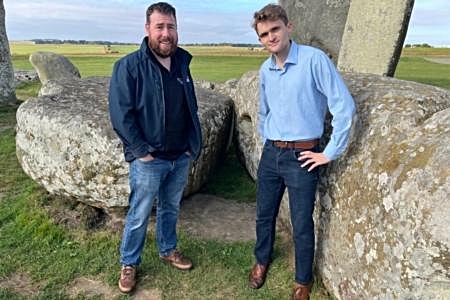Researchers from Curtin University in Western Australia have put forward a new theory regarding the origin of the massive altar stone at Stonehenge. Contrary to previous beliefs that the stone came from Wales, the researchers suggest that it actually originated from Scotland.
The team of scientists from Curtin University’s Timescales of Mineral Systems Group, part of the School of Earth and Planetary Sciences, analyzed the age and chemical composition of minerals found within fragments of the altar stone. The results indicated a match with rocks from northeast Scotland, clearly distinguishing them from Welsh bedrock.
The altar stone, a 50-centimeter thick sandstone block measuring 5 x 1 meters, is located at the center of Stonehenge’s iconic stone circle in Wiltshire. It is believed to have been brought to the site around 5,000 years ago.
Lead author Anthony Clarke, a Ph.D. student, explained that their analysis revealed specific mineral grains in the altar stone that are between 1,000 million and 2,000 million years old. In contrast, other minerals in the stone are around 450 million years old.
“This provides a distinct chemical fingerprint suggesting the stone came from rocks in the Orcadian Basin, Scotland, at least 750 kilometers away from Stonehenge,” Clarke said.
This discovery has significant implications for historians and scientists in understanding ancient communities, their connections, and their methods of transportation.
For Clarke, the findings also hold personal significance. “I grew up in Mynydd Preseli, Wales, where some of Stonehenge’s stones came from,” he explained. “I first visited Stonehenge when I was one year old, and now, at 25, I have returned from Australia to help make this scientific discovery. You could say I’ve come full circle at the stone circle.”

Curtin University Vice-Chancellor Professor Harlene Hayne praised the research and analysis conducted by Clarke and the team at the University’s John de Laeter Centre. The center’s specialist mass spectrometers were used to examine the composition of various materials, including rocks, archaeological artifacts, meteorites, ceramics, and biological substances like teeth, bones, and shells.
“Continuous investment is crucial to maintaining state-of-the-art facilities like this, which help attract the brightest minds from around the world,” Hayne stated.
In this particular case, the University is delighted that Anthony Clarke traveled all the way from his home in Wales, a distance of 15,000 kilometers, to study at Curtin and contribute to this significant finding.
The research was funded by the Australian Research Council Discovery Project and conducted in collaboration with Aberystwyth University, the University of Adelaide, and University College London.

